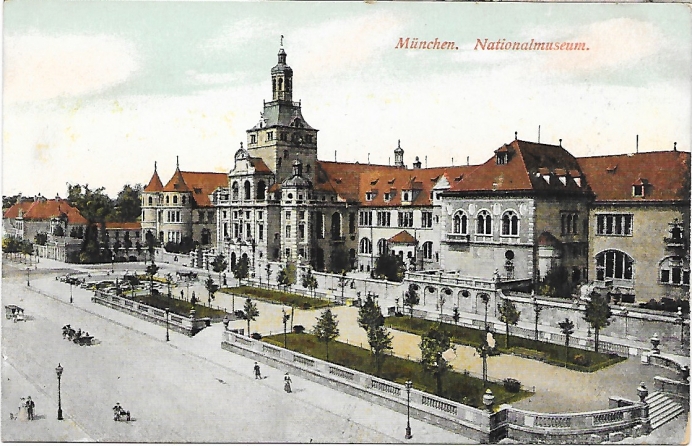I am sorry to say that we arose too late to go to church at which the principal mass is at 9 o’clock, and we will have to wait for the next chance on Himmelfahrts Tag, next Thursday.
I went with the guide to look at the National Museum. This most wonderful collection of historical works of Art is arranged chronologically in 48 rooms, showing the development from prehistoric times to the present day, representing Germany with special reference to Bavaria.

Munich, National Museum.
In the historical section, each room reflects in its fitting up the period to which its contents belongs, and this has reference, too, to the various original ceilings from many different centuries, brought here from old castles, monasteries, peasants homes, etc.
On the other hand again, the architect had to build each room in conformity to the architectural style of its interior fittings, and, sometimes, he had to build special alcoves or ceilings to hold an important decorative object. At the same time, he had to take the exterior into consideration, and when I tell you that he succeeded in skillfully blending the forms of the various styles of architecture, you will understand what an herculean job he succeeded in performing in a satisfactory and artistic manner. His name is Gabriel Seidl, a very suggestive name of München (seidel is same as “Glass with a handle for beer).
I can only touch on some of the many objects we saw beginning with the rooms in the basement, fitted up like the old time torture rooms, also many showing the peasant room interiors of the olden time, a collection of old carriages, leaden coffins from a vault in Lauingen the former residence of the Dukes of Bavaria.
On the ground floor we saw specimen of flintage, consisting of weapons, utensils, and ornaments dating back to 1400 before Christ, to the older and later bronze age up to 900 before Christ, the earlier iron period to 400 before Christ, and the later iron period to the Roman period. Passing through the 48 rooms on this floor, we saw the works of Medieval Art from the early Christian period to the present day as shown in paintings, wood and stone carving, stained glass and beautiful objects in ivory, bone and precious metals, continuing on through these rooms we saw the gradual development from Romanesque to gothic and on to renaissance and modern art.
On the first floor we saw in 35 rooms, special collections, such as Seals of German sovereigns, tins with work of the 16th century, fine Brussels Tapestry, Cpinst [sic] Metals from the Roman period up, laces and embroideries, costumes of the 16th and later centuries, toys of the same period, trophies of the chase and ornamental guns, hunting knives, boar spears, stoves made of tile, insignias, goblets and tools of Munich and other guilds, porcelain, and, last but not least, the rooms fitted up with the personal belongings of some of the Bavarian Kings—Max I (d. 1790), Louis IX (d. 1868), and Max II (d. 1864)—and the state bed and wonderful pieces of furniture of the luxury-loving and mentally unbalanced King Ludwig II, who committed suicide. A wonderful collection of objects made and carved out of ivory, which was started many years ago by one of the Kings and is constantly being added to by the present ruler.
I wandered home and in the afternoon we went to the Austellungs Platz to hear a good concert.
